One of the great enjoyments for car nuts, at least this one, are new and exhaustively detailed books on our favorite topic ... with plenty of photos.
When those books are about people and topics we know personally, that makes the books that much more interesting and exciting ... and they better be correct!
Recently I interviewed two authors for my Sunday evening www.TalkRadioOne.com show, World Racing Roundup, and their books are first-rate. And they're both about topics I happen to know pretty well. Yeah, I even read the books, too (no Larry King am I). You can download the interviews free from the TalkRadioOne.com site.
"Mickey Thompson - The Fast Life and Tragic Death of a Racing Legend" by Erik Arneson, published by MBI and Motorbooks
This was a book just begging to be written since that awful day in 1988 when Mickey and his wife Trudy were, as the Los Angeles County Sheriff put it, "assassinated" in their driveway by thugs hired by a former business partner. That "partner" is now serving two life sentences in a California state prison; the actual hired shooters were never found.
Thompson defined and often dominated American motorsports from the '50s through the '80s; he operated the first professional ¼-mile drag strip in America, Lions Associated Drag Strip in Los Angeles' harbor area, set more land speed records than anyone else at the Bonneville Salt Flats, was so innovative at developing cars for the Indy 500 that many oldtimers shunned his efforts and, finally, brought the excitement of Baja-style off-road racing to major stadiums across the country.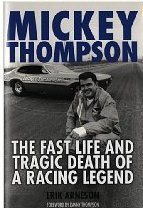
My connection? I knew Thompson well and worked for him between 1978 and 1980, during the time he staged the first major off-road race in the middle of an American city: 1979's Off-Road Championship Grand Prix in the Los Angeles Coliseum. I know the title well because I actually named the event in an office contest --- and got a $1,000 bonus from Mickey (or MT, as we all called him) for coming up with it ... big money for a 25-year old kid back then!
His natural enthusiasm, non-stop energy, impressive promotional abilities and some outrageous personal habits (such as setting his plane on 'autopilot' so he could take a nap, or eating his steak with an ice cream desert on the same plate) are all well-documented.
MT's dad was a big, tough Irish cop in southern California, where MT was born and raised and lived his life, and the kids in that family learned that running home to avoid a fight was much, much worse than actually getting your ass kicked by some bully.
But MT was also a warm and caring person ... something folks who didn't know him well would never guess. Under the obvious gruffness and the anger which would often result in a fistfight between Mick and his latest enemy-of-the-moment, Thompson was a loyal friend, loving husband, son, father and grandfather and would hire people for more money than they ever made after talking with them for five minutes. He was a good boss, too.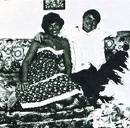 Mickey and Trudy Thompson
Mickey and Trudy Thompson
Arneson, a former USA TODAY writer and now VP of media relations for SPEED television, wrote a book which covers the major sections of MT's life from teenage street racing to the professional drag strip, Bonneville, Indy and Baja and the stadium racing series; it has many pages of photos to document all those efforts.
There's a lot of space devoted to the murders and the subsequent court cases; while this might be a bit dull to readers who don't remember or know the story, the entire affair was so complicated, taking some 20 years from the murders until a conviction, that the details are welcomed to fill-in the blanks.
If the book were fiction, it would be unbelievable. That one man could so dominate so many different aspects of one of the roughest sports in the world and for so many years is one of those stories "you couldn't make up."
But Arneson didn't have to make up any of it; MT did it all, and then some.
"We Were the Ramchargers - Inside Drag Racing's Legendary Team" by Dr. Dave Rockwell; published by the Society of Automotive Engineers/SAE International
The 1950s through the '70s were the glory days of drag racing in America. Not only were the amateur sportsman racers still considered an integral part of the sport by the nascent National Hot Rod Association (NHRA), but there were big, well-funded teams representing the Detroit Three ... sometimes officially, sometimes not so officially ...
Dave Rockwell's book is about the Ramchargers, the team centered around a small group of engineers who were the basis for the Chrysler/Dodge factory effort in both NHRA drag racing as well as NASCAR and other "circle track" events.
I wasn't hanging around drag strips in those days, but a few years ago I ghostwrote a book with Pontiac's lead man in drag racing then, Jim Wangers ("Glory Days - When Horsepower and Passion Ruled Detroit") and feel that I understand what it must have felt like to go to the races in the last '50s and early '60s and who the players were. Incidentally, both Wangers and Mickey Thompson get several mentions in Rockwell's book.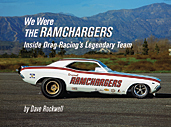
The "engineering" angle is what was unique about the Ramchargers; other pro racing teams from Detroit sometimes came from the "boardroom down" with marketing, PR and other executives putting together the engineers necessary to be the center of a race team.
The Ramchargers started, literally, from the bottom up. Engineers and other related speed freak-types in the Dodge factory spent their evenings developing high-performance engines and cars not officially sanctioned by the boardroom. Like similar unofficial teams from Chevrolet, Pontiac and Ford, the Ramchargers would compete in the infamous "Stop Light Grand Prixs" held nightly on Detroit's Woodward Avenue ... until the cops came.
What began as a secret after-hours club of engineers working with what they considered the "neglected potential" of speed and power around them finally turned into a factory-supported effort which broke the most time barriers in drag racing history and won the most NHRA Super Stock titles during the sport's golden era of factory-vs-factory competition.
The Ramchargers also went a long way towards establishing Chrysler and Dodge in the public mind as young, fun, hip and powerful, things the company had never been associated with in the past. With the demographic studies those days showing a coming "bubble" of young drivers and buyers, Chrysler, like Ford, Pontiac and Chevy, used NHRA drag racing to create the image they wanted.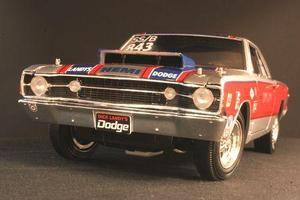 Dick Landy's Dodge was the team's lead car on the west coast for the Ramchargers
Dick Landy's Dodge was the team's lead car on the west coast for the Ramchargers
The Ramchargers arguably developed the first Funny Car and perhaps most enduringly the powerful and bulletproof 426 Hemi which Chrysler sells to this day and is used in race cars and trucks around the world.
These were the days when highly-funded secret engine programs were being run out of the suburban basements of engineers and drivers, racing parts from the factory would be "unofficially" delivered to certain buyers packed in a cardboard box and hidden in the car's trunk when delivered and "cooperative" dealers like Royal Pontiac in Royal Oak, MI, one of the closest dealers to a Pontiac factory, would sell factory-made racing parts out their back doors to "club members" to avoid government and public complaints about the car-makers encouraging speeding.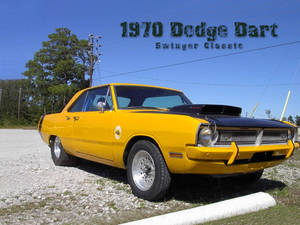 This 1970 Dodge Dart Swinger was helped in its development and sales by the factory drag racing team
This 1970 Dodge Dart Swinger was helped in its development and sales by the factory drag racing team
Rockwell's book has plenty of photos, including two full-page color folio sections, and the author dedicated the tome, "To those who drive American."
Like Arneson's book on Mickey Thompson, We Were the Ramchargers is full of interviews with many of the participants, and a goodly amount of technical information so those under 50 can understand where today's high-performance engines came from, and those over 50 may very well remember from their own drag racing experience.